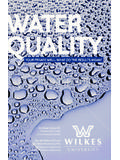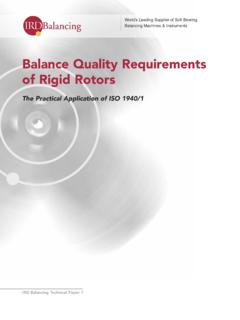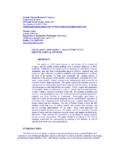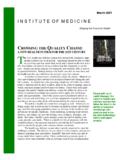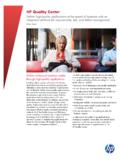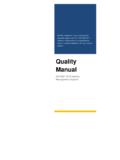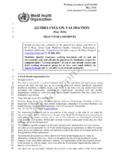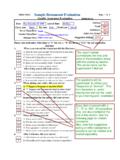Transcription of Deviation Handling and Quality Risk Management …
1 Deviation Handling and Quality Risk Management A note for guidance for the manufacture of prequalified vaccines for supply to United Nations agencies July, 2013 Vaccine Quality and Regulations (VQR), Essential Medicines and Health Products World Health Organization (WHO), Geneva, Switzerland Deviation Handling and Quality Risk Management 2 This guidance document Deviation Handling and Quality Risk Management is one of a series developed by WHO/EMP/HIS Quality , Safety & Standards team upon request from the manufacturers members of the Developing Countries Vaccine Manufacturers Network (DCVMN), with funds of USAID.
2 A set of priority topics has been identified by vaccine manufacturers for WHO to provide guidance on expectations from the vaccine prequalification programme. The guidance document is targeted at manufacturers who are new to the prequalification of vaccines or who require guidance on the level of detail needed for risk assessment for Deviation Management activities. It may also be a useful guide to National Regulatory Authorities (NRAs) in vaccine producing countries. These are not official WHO documents but rather notes for guidance on expected standards to be met for the prequalification of vaccines.
3 Based on WHO recommended requirements, these documents provide further explanations with examples in order to facilitate implementation. Deviation Handling and Quality Risk Management 3 Table of Contents: Page 1. Purpose 4 2. Scope 4 3. Introduction 4 4. Deviation Handling 5 Event Detection 5 Deviation Categorization 6 Deviation Treatment 9 Root Cause Investigation 11 Corrective and Preventive Actions (CAPA) 12 5. Quality Risk Management and Deviations 14 Quality Risk Management Steps 14 Risk Assessment 15 Risk Control 16 Risk Review 16 Risk Communication 16 Purpose of Quality Risk Management 17 Information Sources for QRM 17 QRM Tools 17 Examples of QRM for Production Processes 20 6.
4 Training 24 7. Conclusions 24 8. Glossary 24 9. References 26 10. Acknowledgements 27 Deviation Handling and Quality Risk Management 4 1) Purpose The aim of this guidance document is to contribute to the understanding of a Quality risk Management approach in the Handling of deviations from a practical perspective as per WHO expectations on the matter.
5 This proposal does not have the intent to be prescriptive in any way. The intent is to support effective and timely implementation of tools related to Deviation Management encountered during vaccine and biologicals manufacturing. This guidance document is in line with International Conference on Harmonization (ICH) documents like ICH Q10 Pharmaceutical Quality System, ICH Q9 Quality Risk Management , and with WHO, FDA and EU requirements. It also incorporates the experience of experts and auditors in the field. 2) Scope This note for guidance provides vaccine and biologicals manufacturers with non-binding information concerning the criteria currently used by WHO regarding Deviation Management as part of the assessment of prequalified human vaccines.
6 3) Introduction Among the essential elements of a well established Quality Management System (QMS), Deviation Handling plays a key role in assuring Quality in products and by contributing to continuous improvement. Manufacturers are expected to establish processes and define appropriate controls for measurement and analysis to identify nonconformities and potential non-conformities; defining when and how corrections, corrective actions, or preventive actions should be undertaken. These actions should be commensurate with the significance or risk of the nonconformity or potential nonconformity (7).
7 As part of a comprehensive Corrective and Preventive Actions (CAPA) program, once a Deviation is detected, it needs to be contained with immediate actions ( , corrections), the root causes identified as necessary, and systemic actions implemented ( , corrective actions) as applicable in order to prevent future same or similar non conformances. GMPs have evolved as a consequence and of the inherent risks to the product during manufacturing operations in order to prevent significant deviations. More recently, Quality Risk Management (QRM) has been proposed as a strategy to manage risk in a systematic and documented manner, and has become a requirement of modern GMPs as recommended by international standards like WHO or ICH Q9.
8 Deviation Handling and Quality Risk Management 5 An efficient Deviation Handling system, should implement a mechanism to discriminate events based on their relevance and to objectively categorize them, concentrating resources and efforts in good Quality investigations of the root causes of relevant deviations. A strong CAPA system requires this efficient Deviation Handling system which evaluates the event according to the associated risk, categorizes it and acts accordingly in a timely manner, and verifies the effectiveness of the actions taken. As a formal or informal tool, Quality Risk Management (QRM) has always been part of the analysis process linked to the Handling of events and deviations in pharmaceutical operations.
9 This guidance document proposes a possible strategy to differentiate non-significant events which actually do not affect the product s Quality or violate any norm or defined procedure, from actual deviations which could impact on the product s Quality . 4) Deviation Handling Quality Risk Management was mainly designed to be used prospectively when manufacturing operations are defined and validated. Therefore, potential deviations are identified and avoided by implementing risk control measures and preventive actions. QRM is based on the identification of product attributes and operational parameters which are critical to manufacturing operations in order to identify in advance their associated risks .
10 This guidance document describes how this information may be used as criteria for the categorization and treatment of events, and eventually, deviations. The application of risk Management in dealing with deviations is not only practical but provides a framework for a decision-making process based on a scientifically sound and objective approach, while also enabling decisions to be confidently upheld before the regulatory authorities. Under this approach, a sequence of steps may be identified when Handling events and possible deviations: Event Detection Decision Making Process / Deviation Categorization Deviation Treatment Root cause investigation CAPA Event detection: The manner on how personnel react when in presence of an event is the first challenge to the system, and it largely depends on their level of training, qualification, commitment, and support form upper Management .










